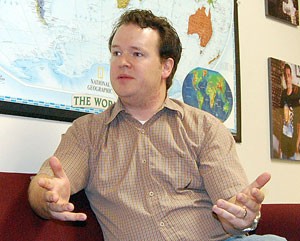Eighty-one units. Another 24 hours of dissertation research. Multilingual requirements. Fieldwork in the Middle East.
These are just a few examples of the demands involved in the rigorous new, and only, dual doctorate program at the UA.
The Near Eastern studies and anthropology departments announced in August that there would be a dual doctorate program with the two disciplines, the first program of its kind in the United States.
The idea for it came about during a Near Eastern studies retreat in the fall of 2006.
“”It’s a perfect situation to pair the geographical depth of Near Eastern studies with Anthropology,”” said anthropology professor Barbara Mills, who at the time of the announcement, was acting head of the Near Eastern studies department.
Another bit of logic for the pairing was the course load for anthropology students, said Michael Bonine, head of the Near Eastern studies department.
“”Some of those students took so much in Near Eastern studies, they might as well have a degree in it,”” he said.
To complete the program, students are required to have a third-year proficiency in a Middle Eastern language, such as Arabic, Persian or Hebrew. They are also required to have a second-year proficiency of a different Middle Eastern language as well as reading proficiency of a European language.
“”You can’t really understand another culture or another society until you know the language,”” Bonine said. “”And at the advanced level, you need to be able to access the literature and scholarship that’s in another language.””
The students’ abilities to understand the language and culture are essential for fieldwork, Bonine said.
“”A lot of the anthropology students in particular have done fieldwork in Morocco or Tunisia or Egypt,”” Bonine said. “”To do fieldwork, you need to be fluent in the language as well as understand the culture.””
Graduate students often use research obtained in fieldwork for their dissertations, he said.
The 105 total units required – and, more critically, the variety of skills they command – will likely mean a small pool of successful applicants, said Brian Silverstein, an assistant professor of anthropology and Near Eastern studies.
“”The kinds of background and experiences and skills that some of them need to have takes quite a bit of time and effort,”” he said.
So far, two students have been accepted into the program: Danielle van Dobben and Ben Adams.
“”When I came here a year ago to interview (as a doctoral candidate), I was still trying to decide between anthropology and Near Eastern studies,”” Adams said. “”Then I found out they were planning (the dual doctorate program), and I didn’t have to decide.””
Adams received his first master’s degree in cultural anthropology from the University of Arkansas in 2000.
He is currently writing his thesis for his second master’s degree in Middle Eastern studies through the American Institute of Beirut.
He was accepted as a doctoral candidate by both Near Eastern studies and anthropology before the dual doctorate program was available.
Van Dobben is currently finishing a thesis in Near Eastern studies at the UA. This will be her second master’s degree, her first in culture and performance attained from UCLA in 2002.
She has already been accepted into the anthropology doctoral program and is waiting to complete her master’s thesis to apply for a doctorate in Near Eastern studies.
Dual doctorate students are expected to graduate in five years, one and a half times longer than a single doctorate would usually take.
The graduate programs in both disciplines have added a few courses that will be eligible for credit toward the dual doctorate.
One is a variation of an undergraduate course called Ethnography of the Middle East. Anne Betteridge, director of Middle Eastern studies and an assistant professor of Near Eastern studies, has been teaching the undergraduate course since 2003.
In the graduate class, students will develop grant proposals to do research in the Middle East.
Silverstein will teach another new course, Culture, Power and History, which will be offered next spring to undergraduate and graduate students.
More information about the dual doctorate program can be found at









